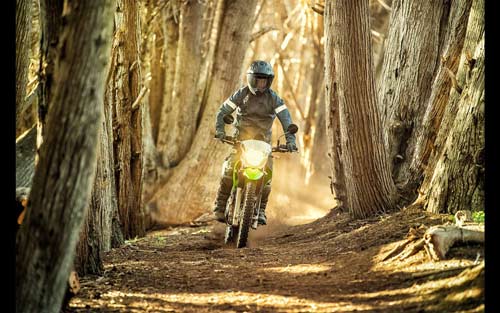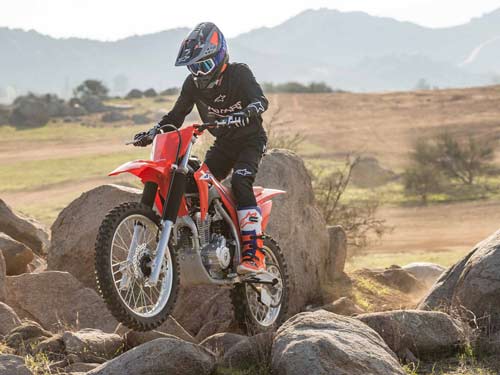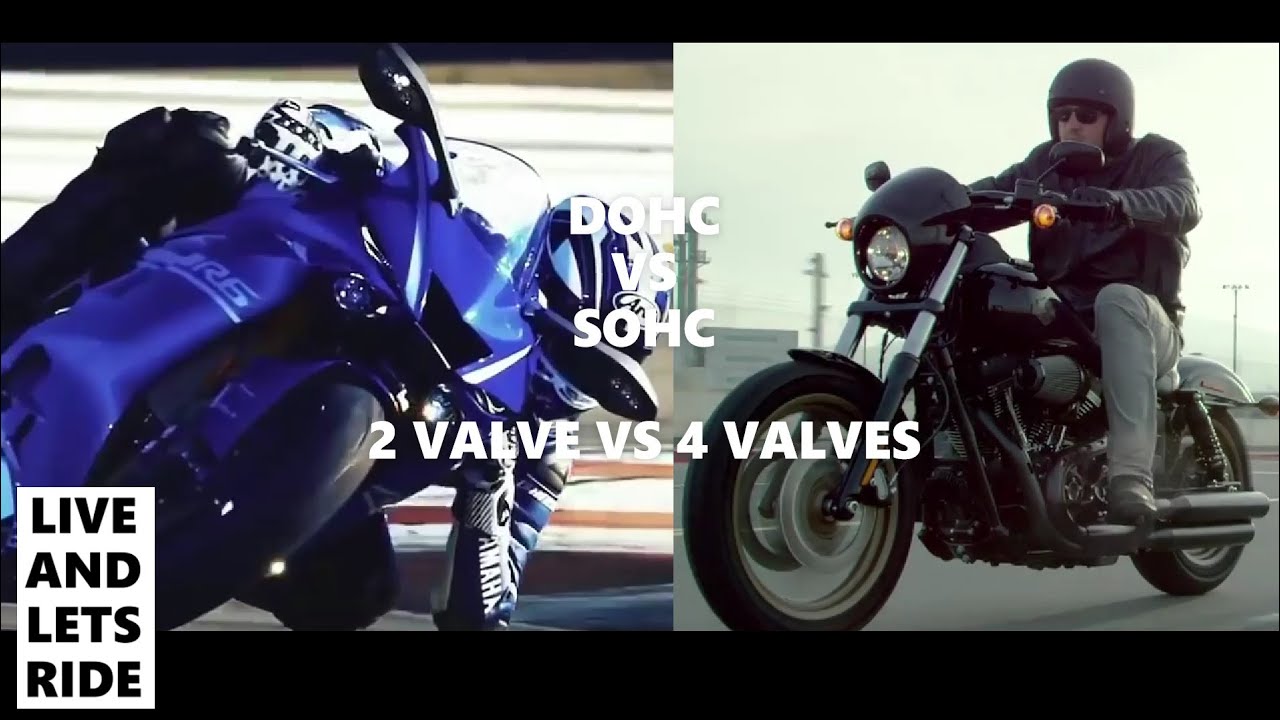As a fervent dirt bike enthusiast, making a choice between the Kawasaki KLX230R vs Honda CRF250F can be a tough decision. These bikes have gained considerable attention for their remarkable fusion of power and affordability in their class. Nonetheless, selecting the best option can be a challenge.
To start, the KLX230R features a 233cc engine, whereas the CRF250F has a 250cc engine that is powerful. KLX230R is featured by an air-cooled single cylinder engine, whereas the CRF250F holds a single cylinder 4-valve engine. Also, the differ in fuel system.
I know that it might be hard to keep track of everything. But don’t worry; I’ll discuss both the matches and distinctions, so you’re covered.
Kawasaki KLX230R vs the Honda CRF250F: A Quick Table
The comparison chart between these two bikes will help you to analyze each bike’s major features quickly. As a result, you’ll be able to observe how the two motorcycles differ easily.
| Feature | KLX230R | CRF250F |
|---|---|---|
| Engine | SOHC, air-cooled single-cylinder | SOHC, air-cooled 4-valve single-cylinder |
| Displacement | 233cc | 250cc |
| Power | 20 Hp | 20.1 Hp |
| Fuel System | DFI | EFI |
| Body Frame | High-strength steel frame | Twin-spar steel |
| Front Suspension | Showa 37mm non-adjustable telescopic fork | Showa 41mm non-adjustable telescopic fork |
| Rear Suspension | Showa shock, spring adjustable preload | Showa shock, spring preload adjustable |
| Seat Height | 36.2-inches | 34.7-inches |
| Fuel Capacity | 1.7 gal | 1.6 gal |
| Weight | 253 lbs. | 264 lbs. |
Comprehensive Discussion on KLX230R and CRF250F
Let’s compare each side of both bikes to understand the aspects of the bikes in-depth.
Engine Specifications
The Kawasaki KLX230R is powered by a 233cc air-cooled 4-stroke engine with a basic yet effective 2-valve SOHC mechanism design. In contrast, the Honda CRF250F is powered by a slightly bigger 250cc air-cooled engine with a more robust 4-valve SOHC design.
When comparing the design, the CRF250F’s 4-valve architecture generates a good amount of torque and horsepower that can crank fast. On the other side, the KLX230R’s two-valve SOHC engine delivers a more fuel-efficient engine that doesn’t run as quickly and can’t produce much power.
Fuel System
Starting with the KLX230R, this motorcycle has a state-of-the-art DFI fuel injection technology, allowing for a smooth start regardless of height or temp. Whether I was riding through the Desert or the Frozen Tundra, the KLX230R started up with no problem.
When it comes to the CRF250F, it has a modern electronic fuel injection (EFI) setup that doesn’t require height adjustments or carb maintenance. So, whichever one you choose, you’re covered by the advanced fuel systems of both dirt motorcycles.
Power
After riding on both bikes, I learned that the CRF250 and the KLX230R are closely matched. The CRF250 has a 20.1 HP engine, whereas the KLX230R has a 20 HP engine, resulting in a little distinction between the two motorcycles.
You won’t find any big differences between the power production of both bikes.
Fuel Efficiency
The Kawasaki KLX230R offers an impressive four-stroke engine which also provides good fuel efficiency with an estimated fuel economy of up to 71.44 mpg. In contrast, the Honda CRF250F offers up to 69.1 mpg.

Overall, both the Kawasaki KLX230R and Honda CRF250F offer riders good fuel economy.
Transmission
In terms of transmission, the KLX230R sports has a six-speed manual gearbox, which provides more gear selections to fit the riding style. The CRF250F, on the contrary, has a five-speed gearbox, which may limit the versatility of acceleration on more difficult tracks.
With a six-speed gearbox, you can enable the engine to operate at lower RPMs, which can aid in fuel savings. This is clearly a benefit for bikers who like taking longer treks on the dirt.
Suspension
If I talk about suspension, the KLX230R is equipped with a Showa 37mm fork and a Uni-Track back shock. It also has 21-inch and 18-inch wheels, which are good for moving around obstacles. But when I went fast, the KLX230R felt a bit shaky on small bumps.
On the other hand, the Honda CRF250F has a Showa 41mm telescopic fork for its suspension. It is good for going around corners and rough terrain. Compared to the KLX230R, I felt the CRF250F’s suspension was more stable and calm.
Top speed
The KLX230R and CRF250F have almost the same top speed of 60 mph. However, if you want to go faster from a stop, you can install a bigger rear sprocket, which will help you accelerate quicker but might lower your top speed.
Handling
The 36.2-inch low seat height, 53.5-inch short wheelbase, and high-strength steel frame of the KLX 230R. It was quite simple to control on the trail because it was swift and sensitive.
The twin-spar steel of the CRF250F provides the rider with a decent mix of strength and comfort. I easily crossed narrow single-track thanks to the bike’s shorter wheelbase of 55.9 inches and lower 34.7-inch saddle height.
Although both bikes have good handling, I find the KLX 230R to be somewhat more agile and the CRF250F to be more suited to confined areas.
Braking System
Both the CRF250F and KLX230R’s braking systems are built to provide strong gripping power. Each of these motorcycles has a 240mm disc and a two-piston caliper for the front brake.

Also, the 220mm disc brake and single-piston caliper at the rear of the bike are intended to balance the braking system.
Price
Cost is certainly a major factor when selecting a dirt bike. The Honda CRF250F costs $4,749 more than the Kawasaki KLX230R, which is priced lower at $4,399 overall.
This leads to the question of why the CRF250F is more expensive. The increased displacement might be the reason..
Overall View on KLX230R and CRF250F
While the CRF250F has a greater hp rating, the KLX230R features a six-speed transmission that could be more flexible for longer outings. And they both feature modern fuel injection technology, so there’s not any major distinction.
Besides, the CRF250F sports a Showa telescopic fork for its suspension, while the KLX230R has Uni-Track rear shock along with a 37mm fork.
Despite this, both motorcycles have strong handling, with the CRF250F being better suited to limited spaces and the KLX 230R being more nimble. Of course, the KLX230R is less expensive overall than the CRF250F at $4,399, which may be a big deal for many riders.
Not to mention, the CRF250F weighs 264 lbs, whereas the KLX230R weighs 253 lbs. Nonetheless, whether for a child or an adult of medium height, the 250F still makes a good beginner bike.
FAQs
I’ll address a few frequently asked questions underneath, which might help you decide between these models.
IS THE KAWASAKI KLX230R GOOD FOR BEGINNERS?
Definitely. The KLX230R has been designed with beginners in mind, boasting a lightweight frame, and a sturdy suspension system. Additionally, taller riders may find the KLX230R to be a better-fit thanks to its taller seat height.”
IS THE HONDA CRF250F STREET-LEGAL?
“Street legal” dirt bikes are off-road motorbikes that have been modified to meet the legal requirements for use on public roads. With that being said, the Honda CRF250F is authorized to ride off-road in all 50 U.S. States.
Conclusion
Look, it’s difficult to determine which bike is better between the Kawasaki KLX230R vs Honda CRF250F. Having said that, I can conclude from the in-depth research that the KLX230R delivers excellent value for the price. Its lightweight design and great suspension make it a perfect option for new and experienced riders alike.
The CRF250F, in contrast, has a more potent engine and a cozy, ergonomic seat that is appropriate for experienced riders. Everything ultimately boils down to the rider’s particular requirements and preferences.
